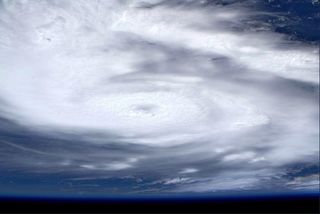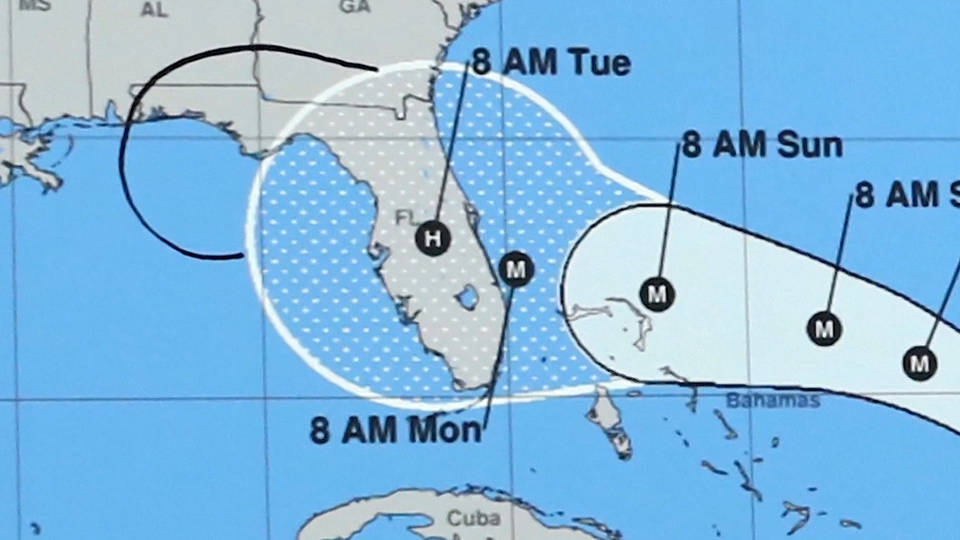
WHILE tens of thousands of Bahamians are struggling to survive in the aftermath of Hurricane Dorian and thousands are missing and feared dead (NOT MY) pres drumpf/trump continues his insane childish rants attacking the media for reporting on his amateurish alterations of a National Weather Service map so that Alabama would be in the possible path of Dorian. All because drumpf/trump can not be wrong, can not make a mistake. He is a sad, pathetic sociopath ( noun a person with a personality disorder manifesting itself in extreme antisocial attitudes and behavior and a lack of conscience. ), a compulsive liar, a disgrace to our country, a SUPERCALLOUSFRAGILRACISTSEXISTNAZIPOTUS. From DemocracyNow! and the Washington Post.....
Trump Personally Altered Map to Promote False Hurricane Threat to Alabama
HEADLINESEP 06, 2019

As Bahamians reel from the historic devastation of Hurricane Dorian, The Washington Post reported that President Trump personally used a black magic marker to alter a map showing the storm’s projected path, in an effort to support his false claim last weekend that Alabama might be hit by the hurricane. In fact, the National Hurricane Center never included Alabama in any of the forecast cones for Dorian. On Thursday, Trump spent a fourth straight day defending his false statements, tweeting, “I accept the Fake News apologies.”
“In the end the Party would announce that two and two made five, and you would have to believe it. It was inevitable that they should make that claim sooner or later: the logic of their position demanded it. Not merely the validity of experience, but the very existence of external reality was tacitly denied by their philosophy. The heresy of heresies was common sense.” - George Orwell, 1984
The tweet below was incorrect.
It was not dramatically incorrect nor was it entirely incorrect. But it was significantly incorrect, in that it suggested a threat to the state of Alabama that didn’t exist at the time it was written.
The National Weather Service was quick to point that out in a tweet that followed President Trump’s, without identifying him directly. But it was important information to correct: The threat of a hurricane leads to fear — sometimes panic — given the threat to life and property that’s implied. Trump’s tweet claimed Alabama (and other states) would be hit harder than anticipated, even though, at the time he sent the tweet, Hurricane Dorian had already shifted northward, as the then-most-recent projected path of the storm indicated.
Alabama, in fact, was going to be hit (much) less hard than it seemed a few days prior. While some early projections of where the storm was headed had it sweeping into Florida and, perhaps, pressing forward into the Gulf of Mexico where Alabama might be at risk, by Sunday morning, when Trump tweeted, Alabama wasn’t even at risk of experiencing tropical-storm-force winds.
During a briefing at Federal Emergency Management Agency headquarters a few hours after he tweeted, Trump nonetheless insisted that Alabama was, indeed, at risk.
Dorian, he claimed, “may get a little piece of a great place: It’s called Alabama. And Alabama could even be in for at least some very strong winds and something more than that, it could be. This just came up, unfortunately. It’s the size of — the storm that we’re talking about. So, for Alabama, just please be careful also.”
Twenty-four hours later, a projection from the National Oceanic and Atmospheric Administration posited that there was a 1-in-20 chance that a small sliver of southeastern Alabama, possibly including the city of Dothan (population: 68,000) would see winds exceeding 39 mph — enough to break twigs off trees and not much more.
Even that small possibility wasn’t indicated in NOAA’s projections on Sunday morning and, by Tuesday morning, it had passed.
Another storm had brewed, though. Trump, incensed at criticism of his incorrect inclusion of Alabama by Jonathan Karl of ABC News, insisted in a tweet on Monday — after returning to the White House from playing golf at his club in Virginia — that “under certain original scenarios, it was in fact correct that Alabama could have received some ‘hurt.’ ” That’s true, but beside the point. Under some original projections, myriad states could have “received hurt”; it’s the nature of hurricane forecasting that early projections are refined to be more accurate over time.
Here, for example, is one early projection, showing that the path of the storm would likely hit northern Florida before curling up to the northeast — basically what happened. Some models, though, showed other paths, heading as far west as Texas or Louisiana or making landfall as far east as North Carolina.
That graphic displays possibilities and isn’t what officials act on. As the graphic itself indicates, it is superseded by updates from the National Hurricane Center (NHC) — the updates shown in the graphics above.
The line-covered map above, though, has become central to Trump’s ongoing insistence that his original tweet mentioning Alabama wasn’t wrong at all. He tweeted that map on Wednesday evening and again on Thursday morning, a response to criticism of his having shared a doctored map of Dorian’s projected path with impacts to Alabama drawn in with black marker.
He paired the Thursday morning map with a refined explanation for why he was correct all along.
“In the early days of the hurricane, when it was predicted that Dorian would go through Miami or West Palm Beach, even before it reached the Bahamas, certain models strongly suggested that Alabama & Georgia would be hit as it made its way through Florida & to the Gulf,” he wrote. “Instead it turned North and went up the coast, where it continues now. In the one model through Florida, the Great State of Alabama would have been hit or grazed. In the path it took, no. Read my FULL FEMA statement. What I said was accurate! All Fake News in order to demean!”
He followed that up a few hours later with another tweet making a similar claim.
What Trump is doing is conflating the idea with Alabama having potentially been at risk at one point with Alabama having been at risk when he tweeted about it. His tweet came shortly before 11 a.m. on Sunday morning and his comments at FEMA came two hours later. At 11 a.m., here was the wind risk posed to Alabama, according to NOAA.
It seems likely that Trump’s FEMA comments were tailored to address his by-then-already-disproved tweet about Alabama. Maybe it wouldn’t be hit hard, but “Alabama could even be in for at least some very strong winds and something more than that" — a development that “just came up” at that point, according to Trump’s full FEMA statement. That is itself, of course, at odds with Trump’s claims that the important factor was modeling from days earlier. (The line-covered map is dated Aug. 28.)
All of this has been fairly well established by now. Trump’s tweet was dismissed as inaccurate by his own National Weather Service’s station in Alabama within a half-hour of his sending it out. Again, it was an important correction to make: Alabamians were incorrectly informed by the president that their state was at risk, and it’s the responsibility of those in positions of authority to quell such unwarranted concerns.
That refutation came four days ago — but here we are, still litigating it.
For Trump, this is a fight worth having because it does two things. It pits the media as oppositional by looping criticism of his initial inaccuracy and his flawed defenses as attacks on him and, by extension, on his supporters. It is also an example of Trump’s unwavering unwillingness to admit mistakes, a central component of his personal survival strategy.
Denying even minor mistakes preserves the possibility that there might be a shred of accuracy in what he’s saying and, therefore, that he’s right and his opponents are wrong. We’ve seen multiple examples of Trump and his supporters dragging goal posts around to prove him right, from his claim that he saw Muslims in New Jersey on 9/11 to his assertions about Trump Tower being wiretapped to the investigation into Russian interference in the 2016 election. In each case, the initial claims evolved or eroded until they reached a point where Trump could be granted a willing suspension of disbelief by those interested in doing so. “What Trump really meant was” could be his presidency’s motto.
In this case, Trump has evolved his explanation from “Alabama will be hit harder than expected” to “modeling at one point included a possible risk to Alabama and also there might have been possible wind damage to the state at some point.” His supporters are active on social media sharing decontextualized maps of Dorian in which unidentified bars of color overlap however narrowly with the state, “proof” that Trump was “right,” because maybe at some point there might have been some threat to the state and, therefore, the fake news is wrong and biased and deserves nothing but the worst.
On Trump’s second day in office, then-press secretary Sean Spicer came to the press room at the White House to tell the press pool that its assessments of attendance at Trump’s inauguration were incorrect and that, in fact, attendance was record-breaking. Spicer’s efforts to prove Trump’s braggadocio about the event were laughable — and, in fact, remain a joke that hovers over Spicer’s post-White House career.
But the motivation for Spicer’s arguments isn’t funny. It is rooted in Trump’s insistence that his truth is the prevailing truth, however narrowly it has to be constrained. Objective facts, like the threat posed by Dorian, must be trimmed or expanded until they meet what Trump has claimed is correct.
Two and two equals five, unless you listen to the lamestream media.
“The Party told you to reject the evidence of your eyes and ears. It was their final, most essential command.” - Orwell, 1984








No comments:
Post a Comment